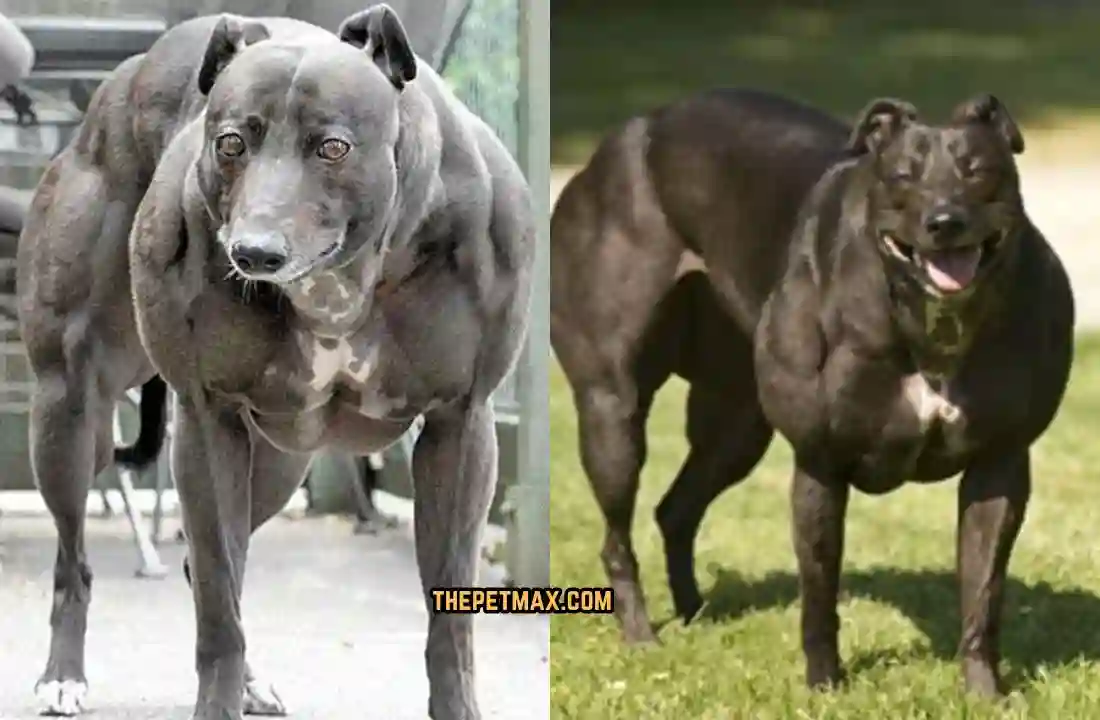Bully Whippet Dog Breed Guide With Pictures

The Bullwhip dog is a designer breed that is a mix of a Whippet and a Bulldog. This cross produced a dog that was less litter and more protective than the Whippet, but stronger and more powerful than the Bulldog.
These dogs excel in sports and are good for activities such as agility, bait racing, and soccer, but they are also good for most activities, including walking, biking, and running. If you’re looking for a medium-sized, very active dog, a blue terrier may be the perfect fit for you.
Contents
- 1 History of Bully Whippet Dog Breed:
- 2 Some Quick Facts about Bully Whippet:
- 3 Bully Whippet Breed Overview & Appearance:
- 4 Temperament of Bully Whippet:
- 5 Are Bully Whippets Good Family Dogs?
- 6 Are Bully Whippets Good with Other Pets?
- 7 Food and Diet Requirements of Bully Whippet:
- 8 Exercise Needs Of Bully Whippet:
- 9 How to Train a Bully Whippet?
- 10 Grooming Needs of Bully Whippet:
- 11 Common Health Problems of Bully Whippet:
- 12 Conclusion:
- 13 FAQ’s:
- 14 Related posts:
History of Bully Whippet Dog Breed:
The Bully Whippet is a rare and unique mutant of the Whippet breed. The genetic condition affects the dog’s muscle mass, making it more muscular compared to the standard Whippet. The Bully Whippet originated from a collection of whippets in the mid-20s. A whippet named Wendy, born in 1951, showed an unusual muscle structure caused by a gene related to the myostatin gene. increases muscle mass.
This unique trait makes Wendy and her offspring look more like a whippet, which is more complex than the physical appearance of a whippet. The difference in muscle development in Bully Whippets is similar to the difference found in Belgian bulls and some human athletes, which causes the muscles to grow faster. However, it should be noted that the Bully Whippet is not a different breed.
However, there is a rare variation in the Whippet breed that is caused by genetics. Breeders who make such changes must use responsible breeding practices to ensure the health and welfare of their dogs. The Whippet Bully is not a popular breed and is rare, with most Whippets meeting different breeds.
Some Quick Facts about Bully Whippet:
- They’re one of the fastest dog breeds, and they can run fast.
- The whippet doesn’t like the cold. They’re fond of cuddling and feeling the warmth.
- The whippet’s a calm pet. It doesn’t bark loudly.
Bully Whippet Breed Overview & Appearance:
Bully Whippets look different from standard Whippets because of a gene that affects muscle growth. The Standard Whippet has a lean, slender, and athletic body type, while the Bully Whippet is more muscular and has a larger body type. This dog has a thicker and tougher build than the average Whippet. Muscle mass has been greatly increased, and muscle tone and muscle mass have been increased, while still maintaining the Whippet’s original body structure.
The Bully Whippet’s body may resemble that of a bodybuilder dog, with more muscles throughout its body. However, in addition to gaining muscle mass, the Bully Whippet retains other physical characteristics of the Whippet breed, such as a lean, sleek build, short coat, and elegant appearance.
| Height | 18-22 inches |
| Weight | 25–40 pounds |
| Lifespan | 12 to 15 Years |
| Temperament | Friendly, gentle, playful |
| Litter Size | 5 to 7 puppies |
| Group | Hound |
| Size | Medium |
| Colors | black, brown / chocolate / liver, cream, fawn, gray, red, white |
| Coat | Short |
| Shedding | Infrequent |
| Puppy Price | $850 to $1,500 USD |
Temperament of Bully Whippet:
Unlike most dogs, this breed is calm, they don’t make noise in the house if something happens to them, and sometimes they bite. They are also calm inside the house, but when you let these dogs outside, their personality and demeanor quickly change, and they are calmer than the intelligent and calm inside.
Unlike their hunting dog cousins, Whippets are very docile and follow commands more easily than other dogs. Sweet and mild, it is known to be gentle on children and other pets, including cats. In this case, it is not surprising that this type of dog is better.
Are Bully Whippets Good Family Dogs?
Bullwhips can make great family pets, but they may not be the first choice for families with young children. These dogs are very patient and protective of children, but if they are not properly trained and socialized, they can be very aggressive and can cause behavioral problems.
If kept in a home with children, bully whips should only be kept with children who have been trained to behave well with dogs. This includes not climbing on the dog, not pulling its ears or tail, and not disturbing the dog while it is eating food or other valuables. With proper training and socialization, the Bullwhip Dog can make a great family dog and thrive in a strong home.
Are Bully Whippets Good with Other Pets?
The bullwhip should be properly socialized and gradually introduced to other animals. The whiplash nature of these dogs tends to chase small animals, such as guinea pigs and rabbits, so it is best to keep them away from small animals.
They’re capable of chasing after cats, too. Bulldogs can be suspicious and suspicious of other animals and do not get along well with other animals. These dogs are very people-friendly, but other animals should be introduced calmly and carefully as they develop relationships with other dogs and cats.
Food and Diet Requirements of Bully Whippet:
Because whip bulls are strong and tough, you need to feed them a balanced, high-protein diet. Bulldogs can easily become overweight or obese, so you need to make sure that the energy your dog consumes is the energy your dog burns.
Otherwise, you will consume too many calories and risk gaining weight. Younger dogs need more calories than inactive, older dogs, so you need to consider your dog’s activity level and you may want to make adjustments as needed. If you are not sure about the right food or how much food for your bullwhip, talk to your vet.
Exercise Needs Of Bully Whippet:
Because Whippets are sprinters and joggers, they really benefit from daily walks and runs. It encourages your Whippet to exercise at least 40 minutes each day, which can include walks in the park and jogging around the neighborhood however you like. Throws are also great for playing fetch. Remember, these dogs were bred to hunt and retrieve games, and eventually, were used to race game by the working classes.
They enjoy chasing toys like Frisbees or fetch balls. You might consider getting another dog to play with your Whippet if you already have a dog, that’s fine too. Just make sure when you invite other dogs over or take your dog to the kennel, you check both animals. Be sure to hold your Whippet while playing in the yard, as this breed has a large appetite and will chase small animals. In addition, this type of dog is not easy to hunt as they can run up to 35 miles per hour, making them the fastest hunting dog.
How to Train a Bully Whippet?
If you bring a puppy home, be prepared to work with a mature and experienced dog. Be consistent with your training and find valuable rewards, such as treats and toys, that will make your dog enjoy the training.
It’s important to use lots of positive reinforcement to build trust with your dog. A whip that does not trust you will be difficult to train and may develop aggression and other behavior problems. If necessary, hire a professional trainer to help you make sure your dog is balanced and obedient.
Grooming Needs of Bully Whippet:
The Bully Whippet is low maintenance, similar to the Standard Whippet. The hair is short and does not require proper care. Regular grooming with a brush or toothbrush will help remove unwanted hair and keep the coat looking beautiful.
Bathing should be done when necessary, for example when the skin is dirty, but do not shower too much as it strips the skin of its natural oils. In addition, attention should be paid to daily hygiene such as nail cutting, dental care, and ear cleaning to maintain health and hygiene. Since the Bully Whippet is not a rare breed, they require the same care as the Standard Whippet, with an emphasis on cleanliness and health without excessive grooming requirements.
Common Health Problems of Bully Whippet:
- Injuries: Whippets have long legs and move quickly, so they can be injured at high speed. Broken skin and broken limbs are the main reason Whippets need veterinary care, proving that speed and coordination do not go hand in hand!
- Eye Problems: Progressive retinal atrophy (PRA) is a hereditary disease found in many breeds of dogs. The plague is not one of the animals that suffer most of the time, but it is known that the disease can occur.
- Heart Problems: Whippets are one of the few breeds that are less susceptible to mitral valve disease (MVD), the canine heart disease. MVD is most common in small to medium-sized dogs, such as Cavalier King Charles Spaniels, Miniature Poodles, Yorkshire Terriers, and Chihuahuas, and often progresses to heart failure when the dog is old. It’s the most common cause of death for old whippets.
- Immune-Mediated Disease: Although not a common problem, Whippets are known to suffer from genetic diseases such as hemolytic anemia (IMHA) and thrombocytopenia (IMTP). Immune mediated diseases are processes in which the body’s immune system attacks its own cells. As with IMHA, the red blood cells of dogs with IMTP are affected and platelets are lost. Immune-mediated diseases can occur naturally but can also occur after stimulation of the immune system, for example by infection, medication or vaccination.
Conclusion:
The Bullwhip is a fun dog, but not for everyone. They can make great pets for individuals or families who are willing to spend time and effort training and socializing them. If you’re into sports like skiing and agility, or if you’re an active person and do a lot of running and walking, the bullwhip is a good friend for you.
These dogs combine the best traits of the Whippet and Bulldog breeds, but like all cross breeds, they have unpredictable genetics, so you never know what you’re going to get until you own it. If you’re ready, able, and willing to work with your dog to help him socialize, get out, and relax, try Bullwhips in your area.
FAQ’s:
Are Bully Whippet dogs rare?
The Bully Whippet is not a different breed, but a genetic trait that results in a muscular body. This mutation causes myostatin to decrease, leading to increased muscle mass in Whippets.
Although rare, these incidents are more anecdotal than what is known in the breed, as they are rare in the general Whippet population. Due to their unique genetic characteristics, they are not widely known and are not recognized by the authorities.
How long do Bully Whippets live for?
The average lifespan of Whippet is about 13 to 15 years. While chronic stress on a Bully Whippet’s organs means we suspect they often die prematurely, conclusive data on this has not been collected.
What do Bully Whippets mean?
While we may joke that these dogs appear ramped up based on their muscle mass, this mutation does not affect their personality. They’re not going to be any more aggressively, hyper or active than they would have been.
Is Bully Whippet Syndrome painful?
As far as we know, the bully whippets don’t seem to be any more unpleasant than their counterparts; they move about and play normal.




